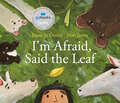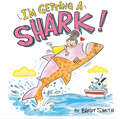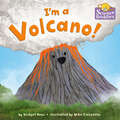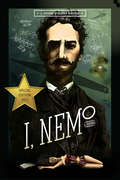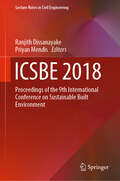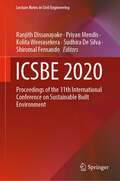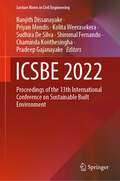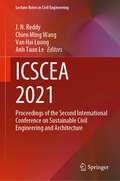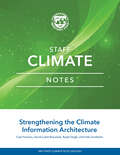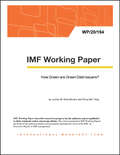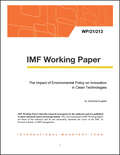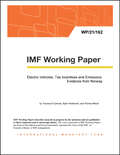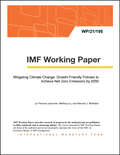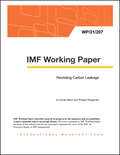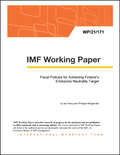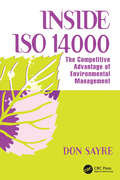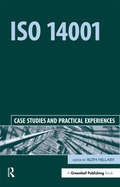- Table View
- List View
I'm Afraid, Said the Leaf
by Danielle DanielA touching, playful exploration of empathy and interdependency from an acclaimed author and illustrator.I&’m afraid, Said the leaf. / You&’re not alone, Said the tree. But who will comfort a nervous bird, a lonely crab, a lost wolf? How can a horse find warmth, a snail some cheer, a child some rest? Through a series of amusing and soothing exchanges, this deceptively simple and profound picture book depicts different pairings to celebrate interconnectedness and underlines the importance of caring for every living organism to ensure a strong and healthy natural world. I&’m Afraid, Said the Leaf invites young readers to understand that we all need each other for support and survival — and that we're all stronger together.
I'm Done!
by Gretchen Brandenburg McLellanA little beaver with a slapdash approach to dam-building comes to appreciate the satisfaction of a job well done in this sweet tale that's perfect for storytime.Nibble, nibble, snap. When Little Beaver sets a single twig across the stream, he figures that should be good enough for a dam. "I'm done!" he calls to Papa before tearing off to play with Fish. But Papa isn't buying it, and it's back to work for Little Beaver. Nibble, nibble, snap, scoop, scoop, pat. Little Beaver sets two more twigs across the stream, and adds some mud before scurrying off with Blue Heron. Mama isn't amused. "You're not done yet." GRETCHEN MCLELLAN'S text explores the value of perseverance at a level perfect for very young readers, while CATHARINE LAZAR ODELLS darling illustrations capture the sweetness of Little Beaver's attempts at perfecting his dam--and the triumph of his eventual success.
I'm Dreaming of a Green Christmas: Gifts, Decorations, and Recipes that Use Less and Mean More
by Anna GettyThe author and green living expert shares savvy tips on how to celebrate Christmas in ways that are eco-friendly and cost-conscious.Anna Getty—a chef, writer, mother, and organic living expert—helps families reduce their carbon footprint and save money while enjoying the festive traditions of Christmas. Anna advises how to best choose a tree (real or fake?), mitigate the negative effects of holiday travel, recycle post-holiday, and more. Anna also shares favorite holiday recipes for organic appetizers and homemade craft ideas such as pinecone wreaths and recycled sweater pillows. With inspiring photographs, extensive resources, and advice from the “Lazy Environmentalist” Josh Dorfman, Seventh Generation’s Jeffrey Hollender, and other leading eco-experts, families might just find that these tips help them stay green all year long—the perfect New Year’s resolution!
I'm Getting a Shark!
by Brady SmithThe fabulous, funny story of a shark-obsessed child who's convinced she's getting a pet shark for her birthday.Meet a little girl who is the biggest shark superfan around! And when she overhears her parents utter the word "shark" while discussing her birthday, her imagination is off and running! She can't wait to be surprised by the pet shark she just KNOWS is coming her way . . . but what kind will it be? As she lists all the possibilities, her disbelieving pooch, Ralphie, tries to set her straight. But she's not paying attention--instead, she is getting more and more excited by the beauty and variety of these awesome creatures. Finally, when her birthday rolls around, she gets a different kind of surprise--a wild shark adopted in her name. She's disappointed at first--but ultimately is proud to play a role in helping protect the creatures she loves so dearly (and is finally listening to Ralphie--who sure knows a lot about sharks for a dog!).
I'm Growing Great (Happy Hair)
by Mechal Renee RoeConfident, empowered girls are celebrated in this follow-up to Happy Hair, a flower-filled, nature-loving, read-together picture book that encourages growth and positivity,Lovely and wise, shine at sunrise! I am growing each day!Beautiful Black and Brown girls with gorgeous natural hairstyles full of flowers, butterflies, and other garden treasures are the stars of this vibrant, rhythmic picture book from the author/illustrator of Happy Hair and Cool Cuts. Set in a backdrop of nature's glorious color and bounty, it's the perfect springtime read-aloud to promote confidence and self-esteem for girls of all ages. Look for all the books in the Happy Hair series:• Happy Hair• Cool Cuts• Smart Sisters• I Love Being Me! (Step Into Reading)• I Am Born to Be Awesome! (Step Into Reading)
I'm Off Then: Losing and Finding Myself on the Camino de Santiago
by Hape KerkelingI'm Off Then has sold more than three million copies in Germany and has been translated into eleven languages. The number of pilgrims along the Camino has increased by 20 percent since the book was published. Hape Kerkeling's spiritual journey has struck a chord. Overweight, overworked, and disenchanted, Kerkeling was an unlikely candidate to make the arduous pilgrimage across the Pyrenees to the Spanish shrine of St. James, a 1,200-year-old journey undertaken by nearly 100,000 people every year. But he decided to get off the couch and do it anyway. Lonely and searching for meaning along the way, he began the journal that turned into this utterly frank, engaging book. Filled with unforgettable characters, historic landscapes, and Kerkeling's self-deprecating humor, I'm Off Then is an inspiring travelogue, a publishing phenomenon, and a spiritual journey unlike any other.
I'm a Volcano! (Science Buddies #2)
by Bridget HeosIn the second installment of the Science Buddies series, a volcano takes young readers through the fascinating formation and life of an active volcano--cool! I mean, hot!How do volcanoes form? What makes them erupt? Are there different kinds? Hi, I&’m Volcano! And I'm here to answer all your burning questions! In friendly, simple text and with funny, engaging, and informative illustrations, a young volcano will teach readers everything there is to know about these exploding wonders. And while volcanoes can be a bit scary, kids will learn that they are carefully monitored and that they give us a lot of beautiful things too! I guess you could say there is a lot to lava about volcanoes!
I've Got a Secret (Candy Apple Book #8)
by Lara BergenQuiet Amanda had the time of her life at summer camp. She made a ton of new friends, like spunky Allie and Kate. She even let everyone think she had a boyfriend. Allie is moving to Amanda's town. Will Amanda's big secret cost her two best friends?
I've Heard the Vultures Singing
by Lucia PerilloAcclaimed poet and MacArthur Foundation Fellow, Lucia Perillo, a former park ranger who loved to hike the Cascade Mountains alone and prided herself on daring solo skis down the wild slopes of Mount Rainier, was diagnosed with multiple sclerosis when she was in her thirties. I've Heard the Vultures Singing is a clear-eyed and brazenly outspoken examination of her life as a person with disabilities. In unwavering and witty prose, and without a trace of self-pity, she contemplates the bitter ironies of being unable to walk, what it's like to experience eros as a sick person, how to lower one's expectations for a wilderness experience, and how to deal with the vagaries of a disease that has no predictable trajectory. Masterfully written, the essays resonate with lovers of literature and nature, and with anyone who has dealt with disadvantages of the body or the hard-luck limitations of ordinary life.
I've Heard the Vultures Singing
by Lucia PerilloAcclaimed poet and MacArthur Foundation Fellow, Lucia Perillo, a former park ranger who loved to hike the Cascade Mountains alone and prided herself on daring solo skis down the wild slopes of Mount Rainier, was diagnosed with multiple sclerosis when she was in her thirties. I've Heard the Vultures Singing is a clear-eyed and brazenly outspoken examination of her life as a person with disabilities. In unwavering and witty prose, and without a trace of self-pity, she contemplates the bitter ironies of being unable to walk, what it's like to experience eros as a sick person, how to lower one's expectations for a wilderness experience, and how to deal with the vagaries of a disease that has no predictable trajectory. Masterfully written, the essays resonate with lovers of literature and nature, and with anyone who has dealt with disadvantages of the body or the hard-luck limitations of ordinary life.
I, Nemo
by J. Dharma Windham Deanna WindhamWhat if the Nautilus and its famous captain wasn't fiction?Every legend has a beginning. Every man has a name. But none as dark and mysterious as the depths of the seas he stalked. The world in time would come to know him as Captain Nemo and his fabulous submarine the Nautilus. Here, for the first time, the tale is told in his own words of how he came to be: I, NemoBorn Jonathan de Chevalier Mason, he had it all: a prestigious position as chief naval engineer to Queen Victoria, a beautiful wife and children, and a bright future, but he was betrayed by the very people he served and loved because he would not divulge the secret of a weapon so terrible that whoever possessed it would rule the world. Thus begins a sordid and shocking ordeal unsurpassed in history. Arrested on false charges and tried in the Star Chamber, a secret court, he is convicted and sent to Belial Island to toil endlessly in its steaming tropical jungles. Then fortune smiles on him in the guise of a frail elderly French priest and his little band of followers. Together the two men hatch a plot to escape and forever be free of tyrannical governments that cast them aside like trash. But Jonathan has a score to settle and soon his betrayers will feel his wrath.I, Nemo is a steampunk novel written in Dharma and Deanna's signature style, historical fact blending seamlessly with fiction, it is an action packed, gut wrenching roller coaster ride of torrential proportions. Starting with 20,000 Leagues Under the Sea, J. Dharma & Deanna Windham have added greater depth and vibrancy to this time honored classic, creating something altogether unique and different.
ICSBE 2018: Proceedings of the 9th International Conference on Sustainable Built Environment (Lecture Notes in Civil Engineering #44)
by Ranjith Dissanayake Priyan MendisThis book highlights current research and development in the area of sustainable built environments, currently one of the most important disciplines in civil engineering. It covers a range of topics, including sustainable construction and infrastructures, waste and wastewater management, enhanced sustainability, renewable and clean energy, sustainable materials and industrial ecology, building automation and virtual reality, and impact of climate change. As such it provides vital insights into responsible urbanization practices, and new tools and technologies in civil engineering that can mitigate the negative effects of the built environment.
ICSBE 2020: Proceedings of the 11th International Conference on Sustainable Built Environment (Lecture Notes in Civil Engineering #174)
by Ranjith Dissanayake Priyan Mendis Kolita Weerasekera Sudhira De Silva Shiromal FernandoThis book highlights the latest knowledge and innovations in the field of civil engineering and construction industry striving for a sustainable built environment. It includes recent innovative findings from the proceedings of the 11th ICSBE 2020 under the themes of sustainable tall buildings, sustainable bridge construction and maintenance, waste in construction industry, sustainable manufacturing and recycling, disaster risk reduction for sustainable built environment, green innovations and entrepreneurship, sustainable water management in developing countries, water pollution and CKDu, sustainable urban environment and social well-being, and many greener and sustainable resource and energy-efficient innovative research findings.
ICSBE 2022: Proceedings of the 13th International Conference on Sustainable Built Environment (Lecture Notes in Civil Engineering #362)
by Ranjith Dissanayake Priyan Mendis Kolita Weerasekera Sudhira De Silva Shiromal Fernando Chaminda Konthesingha Pradeep GajanayakeThis book highlights the latest knowledge and innovations in the fields of civil engineering and construction industry striving for a sustainable built environment. It consists of high quality and innovative research findings selected from the proceedings of the 13th ICSBE 2022 under the themes of sustainable construction, urban green infrastructure and planning, rainwater harvesting and water conservation, high-performance concrete, indoor environmental quality and indoor plants, wind and hydro-power energy, waste and wastewater management for enhanced sustainability, impacts of climate change, carbon footprint, global climate model and landscaping, material flows and industrial ecology, sustainable materials, etc.
ICSCEA 2021: Proceedings of the Second International Conference on Sustainable Civil Engineering and Architecture (Lecture Notes in Civil Engineering #268)
by J. N. Reddy Chien Ming Wang Van Hai Luong Anh Tuan LeThis book presents articles from the Second International Conference on Sustainable Civil Engineering and Architecture, held on 30 October 2021 in Ho Chi Minh City, Vietnam. The conference brings together international experts from both academia and industry to share their knowledge, expertise, to facilitate collaboration and improve cooperation in the field. The book highlights the latest advances in sustainable architecture and civil engineering, covering topics such as offshore structures, structural engineering, construction materials, and architecture.
IMF: Recent Economic Developments (Imf Staff Country Reports #Imf Staff No. 97/107)
by International Monetary FundA report from the International Monetary Fund.
IMF: Recent Economic Developments (Imf Staff Country Reports #Imf Staff No. 97/107)
by International Monetary FundA report from the International Monetary Fund.
IMF: Recent Economic Developments (Imf Working Papers #Imf Staff No. 97/107)
by International Monetary FundA report from the International Monetary Fund.
IMF: Recent Economic Developments (Imf Working Papers #Imf Staff No. 97/107)
by International Monetary FundA report from the International Monetary Fund.
IMF: Recent Economic Developments (Imf Working Papers #Imf Staff No. 97/107)
by International Monetary FundA report from the International Monetary Fund.
IMF: Recent Economic Developments (Imf Working Papers #Imf Staff No. 97/107)
by International Monetary FundA report from the International Monetary Fund.
IMF: Recent Economic Developments (Imf Working Papers #Imf Staff No. 97/107)
by International Monetary FundA report from the International Monetary Fund.
IMF: Recent Economic Developments (Imf Working Papers #Imf Staff No. 97/107)
by International Monetary FundA report from the International Monetary Fund.
INSDE ISO 14000: The Competitive Advantage of Environmental Management
by Donald Alford SayreThe International Organization for Standardization (ISO) has a master scheme in mind for the protection and preservation of the environment, for sustainable development of life and improving the ecosystem. They call it ISO 14000, the standard and guidelines for effective environmental management systems.Inside ISO 14000 does what its title sugg
ISO 14001: Case Studies and Practical Experiences
by Ruth HillaryISO 14001 is the star standard among the International Organization for Standardization's ISO 14000 series of environmental management standards. It has seen spectacular growth since its launch in September 1996. Worldwide registrations are set to pass the 20,000 mark in 2000 with 20 times that number reportedly waiting in the wings.In 30 explicit but concise chapters, ISO 14001: Case Studies and Practical Experiences seeks to unravel the truth behind what can and cannot be achieved by ISO 14001 and aims to provide readers with enough knowledge to make choices about its relevance and importance not only to their worlds but also to society. Written by leading practitioners, certifiers, consultants, government and academics, the book examines both the real benefits and the shortcomings organizations have experienced with ISO 14001. We learn from both.Far more ambitious than an implementation guide, the book will provide those readers struggling with the standard first-hand experiences of the real issues they will face in implementing their EMS and, just as importantly, what certifiers look for when they visit firms. ISO 14001: Case Studies and Practical Experiences is a warts-and-all expose of ISO 14001: the issues tackled; the problems faced and overcome; and, above all, the astonishing flexibility of its uses and the diversity of its users.This important book is a must for businesses, researchers, consultants, government officials, students, NGOs and support organisations who want more than just another how-to-do-it manual; but rather the truth about how ISO 14001 is really working on the ground.
